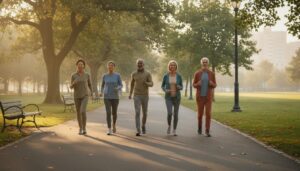Why Care Changes After 50
Turning 50 doesn’t mean slowing down—it means being intentional. Hormonal shifts, gradual loss of muscle mass, bone density changes, and cardiovascular risk all start to matter more. The goal is to preserve function, independence, and joy through smart prevention and daily habits.
Annual Checkups and Screenings
Regular preventive care is the highest‑ROI habit after 50. Work with your clinician to personalize timing based on your history.
Core Screenings (All Adults)
- Blood pressure: at least annually; target typically <130/80 mmHg if tolerated.
- Lipids: every 4–6 years (more often with risk factors).
- Blood sugar/A1c: every 3 years (annually if prediabetes or risk).
- Colorectal cancer: colonoscopy every 10 years or stool tests per guidance.
- Vaccines: influenza yearly; Tdap once with Td booster every 10 years; shingles (2 doses); pneumococcal per age/risk.
Women‑Focused
- Breast cancer screening: mammography per local guidelines (often every 1–2 years).
- Cervical cancer: HPV testing intervals per guidance; may stop after adequate negative screens and age.
- Bone density (DEXA): at or after menopause; sooner with risk factors.
Men‑Focused
- Prostate health: discuss PSA screening, weighing benefits/harms.
- Abdominal aortic aneurysm: one‑time ultrasound for male smokers or former smokers (typically 65–75).
Exercise After 50: The Foundational Routine
Aim for weekly movement that hits all four pillars: aerobic, strength, mobility, and balance. Start low, go slow, and be consistent.
Weekly Targets
- Aerobic: 150–300 minutes moderate (e.g., brisk walk, cycling) or 75–150 minutes vigorous, plus daily step goal (6–10k as tolerated).
- Strength: 2–3 nonconsecutive days; focus on major muscle groups (legs, hips, back, chest, core, arms).
- Mobility: 5–10 minutes most days (hips, hamstrings, thoracic spine, shoulders).
- Balance: 2–3 sessions/week (single‑leg stands, heel‑to‑toe walk, tai chi).
Sample Full‑Body Strength Circuit (Beginner)
- Sit‑to‑stand from chair: 2–3 sets of 8–12 reps.
- Wall or countertop push‑ups: 2–3 sets of 8–12 reps.
- Hip hinge with light dumbbells (or backpack): 2–3 sets of 8–12 reps.
- Static lunge or assisted split squat: 2–3 sets of 6–10 reps/side.
- Band row or door‑anchor row: 2–3 sets of 8–12 reps.
- Dead bug or bird‑dog for core: 2–3 sets of 6–10 reps/side.
Safety tips: warm up 5 minutes, use smooth tempo, breathe (don’t Valsalva), and stop for chest pain, dizziness, or unusual shortness of breath.

Brisk walking is a joint‑friendly aerobic staple.

Chair squats build leg strength safely.

Gentle yoga enhances mobility and balance.
Nutrition for Longevity and Energy
Nutrition needs shift toward protein for muscle maintenance, fiber for cardiometabolic health, and micronutrients for bones and immunity.
Daily Plate Priorities
- Protein: ~1.0–1.2 g/kg/day; include a protein source at each meal (fish, poultry, lean meats, eggs, tofu/tempeh, Greek yogurt, legumes).
- Fiber: 25–38 g/day from vegetables, fruits, legumes, whole grains; supports heart, gut, and glucose control.
- Healthy fats: emphasize olive oil, nuts, seeds, avocado; include omega‑3s (fatty fish 2x/week or algae‑based DHA/EPA).
- Calcium/Vitamin D: prioritize food first (dairy or fortified alternatives, leafy greens); check vitamin D level for targeted supplementation.
- Hydration: 6–10 cups/day depending on body size, meds, activity; watch for dehydration signs.
Simple 1‑Day Sample Menu
- Breakfast: Greek yogurt parfait with berries, chia, and walnuts; green tea.
- Lunch: Lentil‑veggie soup with side salad and olive‑oil vinaigrette; whole‑grain roll.
- Snack: Apple with peanut or almond butter.
- Dinner: Baked salmon (or tofu) with quinoa, roasted broccoli, and lemon‑tahini sauce.

Colorful, fiber‑rich salads support heart and gut health.

Balanced meals: lean protein, whole grains, and vegetables.
Bone, Muscle, and Metabolic Health
- Bone: pair calcium/vitamin D with resistance training and impact (walk, light jumps if appropriate).
- Muscle: prioritize protein timing (20–35 g per meal) and progressive overload in training.
- Metabolic: limit refined sugars, ultra‑processed foods, and excessive alcohol; prioritize sleep and stress management.
Stress, Sleep, and Mental Well‑Being
- Sleep: aim 7–9 hours; maintain consistent schedule; limit screens before bed.
- Stress: practice daily 5–10 minute breathing, meditation, or prayer; enjoy nature and social connection.
- Cognition: learn new skills, read, or play strategy games; combine with exercise for additive benefit.
Sex‑Specific Considerations
Women
- Menopause: discuss symptoms (hot flashes, sleep change, mood) and options including lifestyle, non‑hormonal meds, or hormone therapy when appropriate.
- Bone preservation: resistance training + adequate protein and calcium/vitamin D.
- Heart health: risk rises after menopause—prioritize BP, lipids, exercise, and diet.
Men
- Testosterone: focus first on sleep, exercise, weight management; discuss testing/therapy only if symptomatic.
- Prostate/urinary: monitor urinary changes; seek evaluation for new symptoms.
- Muscle preservation: progressive resistance training is non‑negotiable.
Medications and Supplements: Use Wisely
- Regularly review meds with your clinician to minimize polypharmacy and interactions.
- Supplements should fill verified gaps; avoid megadoses without indication.
- If you take anticoagulants, diabetes meds, or BP pills, ask about exercise/diet adjustments.
Red Flags: Seek Care Promptly
- Chest pain/pressure, shortness of breath, or new neurologic deficits (call emergency services).
- Unintentional weight loss, persistent fatigue, or bleeding changes.
- Falls, balance changes, or rapid functional decline.
Putting It Together: A Weekly Template
- Mon: 30–45 min brisk walk + 10 min mobility.
- Tue: Strength circuit (30–40 min) + 5 min balance.
- Wed: Active recovery (easy cycling or swim) + stretching.
- Thu: Strength circuit + short walk.
- Fri: 30–45 min brisk walk + balance drills.
- Sat: Recreational activity (hike, dance, sports) + mobility.
- Sun: Rest, meal prep, and social time.
This guide is educational and does not replace personalized medical advice. Speak with your healthcare professional before making significant changes to exercise, diet, or medications.
